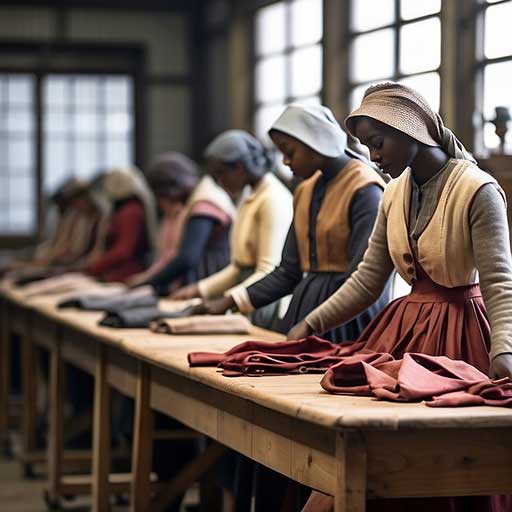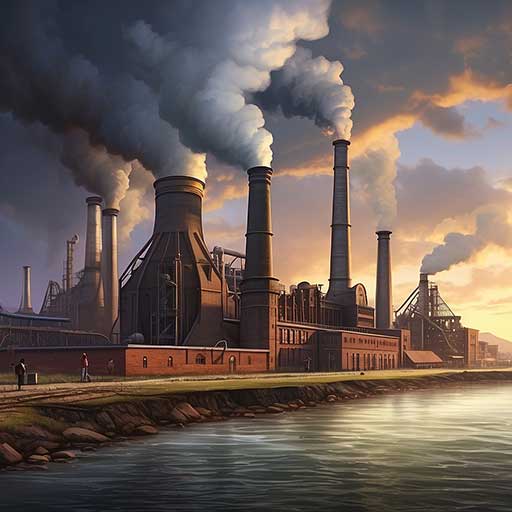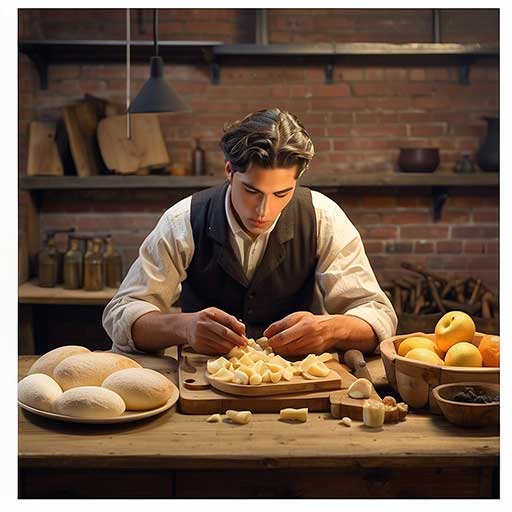How were Clothes Made before the Industrial Revolution?
Before the Industrial Revolution, clothes were made through a process known as domestic production. This meant that most clothing was created at home by either hand-weaving or using spinning wheels to spin yarn into fabric. Hand-sewing and needlework were used to construct garments from these fabrics.
It was not uncommon for people to make their own clothing, as well as those of family members and friends. The fabrics used in pre-Industrial Revolution clothing varied depending on what was available in the local area; wool and linen were commonly used in Europe while cotton became more popular after it began being imported from India during the 1700s. While this method of making clothes is time consuming, it allowed for much more intricate designs than machines would have been able to produce at the time.
Prior to the Industrial Revolution, most clothing was handmade by individuals or small family-run businesses. Clothes were created using simple tools such as needles and scissors, and fabrics were usually made of natural materials like cotton, wool, linen, and leather. Colors were achieved through natural dyes derived from plants or minerals – a process that often took weeks if not months to complete.
Clothing production was incredibly time consuming and labor intensive requiring a great amount of skill and dedication on the part of those who crafted them. This period marked an important shift in clothing history when artisans began producing garments for mass consumption at larger scales than ever before.
How Clothes were Made before Machines?

Before the invention of machines, clothes were made entirely by hand. This involved several steps such as cutting fabric, sewing seams and hems, pressing cloths to create a smooth finish and adding decorative elements like buttons or embroidery. The process was laborious and time consuming but allowed for more intricate designs than those created with machines today.
Tools used in this process ranged from thimbles to help sewers hold small pieces together, awls to punch holes through thick materials, needles for stitching fabrics together, shears for cutting fabric into shapes and sizes needed for garments, measuring tapes or rulers to ensure accuracy when cutting out patterns from fabric pieces , pincers to press material down firmly while sewing it together along edges and curves that could not be done with just fingers alone. It was also common practice at the time to dye fabrics before being cut into clothing items which added another layer of complexity.
How were Clothes Made As a Result of the Industrial Revolution?
The Industrial Revolution brought about significant changes in the way that clothing was produced. Prior to this time, most clothing had been made by hand at home or in small workshops. With the arrival of new technologies and machines, more efficient methods for producing garments could be used, including power looms and other mechanized weaving tools.
This allowed for increased production speeds and a much larger output than before. As a result of these advances, clothes began to be mass-produced in large factories with workers who specialized in specific tasks such as cutting fabric or sewing seams together. Clothes were now being created faster and cheaper than ever before – providing an affordable option for all classes of people across the world.
Who Made Clothes before the Industrial Revolution?

Before the Industrial Revolution, people made their own clothes by hand, using traditional techniques such as spinning and weaving. People would spin yarn from fibers like wool or cotton using a spinning wheel or distaff and spindle. They then wove the yarn into fabric on a loom, which could be wooden or of some other material depending on what was available in their area.
Cloth could then be cut to shape and sewn together with needles and thread to make clothing. This was time-consuming work that usually took place in small workshops run by individual tailors or seamstresses who specialized in making specific pieces of clothing for customers. In addition to these craftsmen, rural communities relied heavily on folk costume designers known as “patternmakers” who created patterns for garments that were easy for home sewers to replicate at home with minimal skills and resources available to them.
What is the Oldest Method of Making Cloth?

The oldest known method of making cloth is by hand-weaving. This ancient craft dates back to Paleolithic times, when people used looms made from sticks and string to create basic garments. Hand-weaving continues today in many cultures around the world and involves using a loom to interlace two sets of yarns or threads – the warp (lengthwise) and the weft (crosswise).
The weaver then manipulates these threads with their hands or feet, creating patterns that range from simple plaids to complex geometric designs. This technique has been used for thousands of years as a way to make clothing, blankets, rugs, tapestries, and other fabric items.
Textile Manufacturing Before the Industrial Revolution
How were Clothing And Food Made After the Industrial Revolution
The Industrial Revolution ushered in a new age of production, and with it came major advancements in the manufacturing of clothing and food. Clothing was mass produced using automated machinery, while food was processed faster than ever before. The advent of industrialization also enabled people to access an unprecedented variety of clothing materials and flavors for their meals.
As a result, these industries saw tremendous growth over time as more people had access to affordable goods.
What were the Sources of Power before the Industrial Revolution

Before the Industrial Revolution, power sources were largely limited to human and animal muscle. This included activities such as plowing fields with oxen, grinding grain by hand with a mortar and pestle, and carrying goods over long distances on foot or in carts pulled by horses or donkeys. Windmills also provided some power for certain tasks like milling grain into flour.
In addition to these physical sources of energy, humans had access to waterwheels which could be used for a variety of purposes including pumping water from wells or providing mechanical motion for industrial machines such as saws and hammers.
How were Clothes Made before the Industrial Revolution Quizlet
Before the Industrial Revolution, clothes were made largely by hand. People spun raw fibers into yarn using a spinning wheel and then used looms to weave the yarn into cloth. This process was labor intensive, time consuming, and expensive – limiting the number of garments that people could own.
Furthermore, since most textiles had to be created with natural materials like wool or cotton that grew slowly in certain climates, much of this work was done locally.
How was Food Made before the Industrial Revolution

Before the Industrial Revolution, food was made by hand and with simple tools. Farmers grew crops, raised livestock, and hunted game to provide families with sustenance. Food was often cooked over a fire in an outdoor kitchen or in a simple clay oven.
Artisanal breads were made from locally-ground grains, while dairy products were either collected from wild animals or produced on farms. In many cases, what couldn’t be grown or caught had to be traded for through bartering or purchased at local markets.
Conclusion
The history of clothing and textile production before the Industrial Revolution is fascinating. Before this period, clothes were made in homes with limited tools and materials available. Although it was a time consuming process, people still managed to create beautiful garments that could last for many years.
It’s remarkable to think about how far we have come since then, as technology has allowed us to mass produce items much faster than ever before. With this knowledge, we can appreciate the amazing skill that went into pre-industrial clothing making even more.

Hi, Musette Beaulieu here. Being a full time housewife makes me a geek for washing and drying clothes. Who doesn’t love fresh smelled clothes? Carry on with me, I hope you get what you seek in this clothes drying journey.
